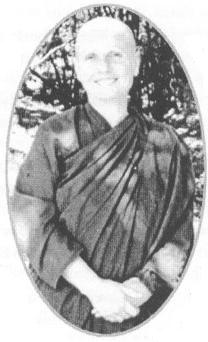 我在1963年出生於澳洲雪梨。從小我就是天主教徒,十幾歲時,我不再上教堂了,獨自想從其他方面尋找人生意義和方向。當時我對學術研究不太感興趣,但對藝術卻有天生的偏好;除了對生命存在的問題外,其他什麼都引不起我的興趣。藝術和繪畫就是我審察內在和外在世界、覺知和良心的特性的方法。念大學的那幾年,這樣的思考精神領域就更明確了。 我在1963年出生於澳洲雪梨。從小我就是天主教徒,十幾歲時,我不再上教堂了,獨自想從其他方面尋找人生意義和方向。當時我對學術研究不太感興趣,但對藝術卻有天生的偏好;除了對生命存在的問題外,其他什麼都引不起我的興趣。藝術和繪畫就是我審察內在和外在世界、覺知和良心的特性的方法。念大學的那幾年,這樣的思考精神領域就更明確了。
在 70年代和 80年代時期,作為一個年輕的藝術家,生活是令人振奮的 -- 內在外在的各種限制,都受到了挑戰,並瓦解了,但「苦」和苦因,卻仍得不到解答 -- 知足常樂和真正的快樂,也捉摸不定。因此尋找生命的意義、目的和真理也更就形迫切了。
從藝術學院畢業後幾年,我買了張單程機票,離開澳洲去觀看世界 -- 也許在「外面的世界。對「生存困境」,更能找到答案 -- 畢竟,假如我要表達真理,就要先找到真理。那年我快23歲了。
我和一個朋友結伴到東南亞、印度、歐洲去旅行,幾乎每天馬不停蹄各處走,就只帶了個背包。這種生活方式我覺得很自由,也容易靜坐。當我停下來時,已經過了八個月了。這時我準備向內心做更深一層的訓練,也厭倦了各處旅行。我了解向外尋求是找不到答案的,煩惱依舊。我只要靜止,要靜坐。
之後發生了一連串的事情。離我住處不遠,有座佛教精舍開辦靜坐課程。
幾個月後,那精舍安排我到倫敦北部的永生寺去,在那兒我申請靜修。十天的授課、練習、佛法反觀之後,我知道我終於找到了我所追尋的 -- 這對我過去的經歷和這個世界,都有了合理的解釋(指向這條路)-- 我鬆了一口氣!聽聞佛法,特別是四聖諦,改變了我的一切。接下來的12個月我練習不同的靜修方式。
我感覺和永生寺的人,及阿姜查和阿姜蘇美度的教導,有強烈的關係。我常回那兒。最後我的目標終於明確了,我要求像出家人一樣在那兒住,在那兒修行,並於1988年受八戒,1990年受「尸羅陀羅戒法」(註)
我在英國寺廟居住,有時也到澳洲去,幾年下來,我期待能有更多時間獨處,專注靜坐。1999年我到美國加州的無畏寺,在那兒我有更長時間的獨自靜修。
※佛教南傳傳統。沒有受比丘尼戒法。「尸羅陀羅戒法」1983年英國起始,以10戒為主,加上120條戒法,近似比丘尼訓練。 |
|
I was born in Sydney, Australia, in 1963. Though brought up as a Catholic, by my mid-teens I had stopped going to church, finding more independence to seek meaning and direction in other areas. While not very drawn to academic studies, I'd always had a keen interest and a natural tendency in the field of art. Nothing else seemed to hold my interest very much, except for the preponderance of life's existential questions. Art and painting became my means for investigating the inner and outer world, and the nature of perception and consciousness. Through my college years, the spiritual dimension of such contemplations grew more pronounced.
As a young artist in the 1970's and 80's, life was exciting - boundaries of all kinds, inner and outer, were being challenged and falling. The question of suffering and its cause however remained unanswered - contentment and real happiness elusive. The search for meaning, purpose and Truth became more driven.
Several years after graduating from art college, I left Australia on a one-way ticket to see the world - perhaps there would be more clues to the existential dilemma "out there" - after all, if I wanted to be able to express the Ultimate Truth I would need to find it first! I was nearly 23.
Together with a friend, I traveled through Southeast Asia, India and Europe. Moving on virtually every day from place to place, with all that one owned on one's back, was a way of life I found quite freeing and very conducive to contemplation. By the time I stopped for a while, some eight months later, I was ready for a deeper turning within. I was weary of moving around. I'd realized that there were no answers "out there", that suffering was the same everywhere. I just wanted to be still, to meditate.
A series of synchronistic events occurred. A Buddhist vihara (house), not far from where I was living was offering meditation classes. From there, some months later, I was directed to Amaravati Monastery, just north of London, and booked myself in on a retreat. Ten days of instruction, practice and Dhamma reflections - and I realized I had found what I was looking for. Something at last that made perfect sense - of the world and of my experience. What a relief! To hear the Buddha's teachings, especially of the Four Noble Truths, changed everything. I spent the next 12 months practicing in different retreat situations.
I felt a strong connection with the community at Amaravati and the teachings of Ajahn Chah and Ajahn Sumedho, and I kept returning. Eventually, my priorities became clear and I asked to live and practice in the way of the monastic Sangha there - taking Anagarika (Eight-precept) ordination in 1988 and Siladhara ordination * in 1990.
After living and training in the monasteries in England for some years, as well as spending periods time in Australia, a desire to spend more time alone to focus on and develop the formal practice of meditation grew. In 1999 this brought me to Abhayagiri Monastery in California, where I had been offered the opportunity to do an extended period of solitary retreat.
* In the Theravadin tradition, Bhikshuni ordination is not available to us. The Siladhara form for nuns has evolved in England with this lineage since 1983. It is based on the ten-precept ordination, with a body of 120 training rules and observances that closely reflect the Bhikshu and Bhikshuni way of training. |